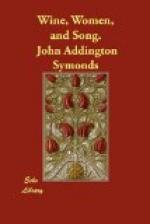After all, it is safer to indulge in no constructive speculations where the matter of inquiry is both vague and meagre. One thing appears tolerably manifest; that many hands of very various dexterity contributed to form the whole body of songs which we call Goliardic. It is also clear that the Clerici Vagi considered themselves a confraternity, and that they burlesqued the institutions of a religious order, pretending to honour and obey a primate or bishop, to whom the nickname of Golias was given at the period in which they flourished most. Viewed in his literary capacity, this chief was further designated as the Archpoet. Of his personality we know as little as we do of that of Homer.
FOOTNOTES:
[Footnote 36: Grimm’s Gedichte des Mittelalters, p. 232.]
[Footnote 37: Carm. Bur., p. 254.]
[Footnote 38: Page 69.]
[Footnote 39: Giesebrecht in Allg. Monatschrift. Jan. 1853. p. 35.]
[Footnote 40: Op. cit., p. 182.]
[Footnote 41: Ib., p. 232.]
[Footnote 42: Ib., pp. 238, 239.]
[Footnote 43: Published at Parma, 1857.]
[Footnote 44: See Novati, Carmina Medii Aevi, p. 8, note.]
[Footnote 45: Decameron, i, 7.]
[Footnote 46: See above, p. 21.]
[Footnote 47: Grimm, op. cit., p. 189 et seq.]
[Footnote 48: Giesebrecht identifies Walter of Lille with the Archipoeta. But he seems to be unacquainted with Salimbene’s Chronicle, and I agree with Hubatsch that he has not made out his point.]
[Footnote 49: Op. cit., p. 235, also in Carm. Bur., p. 74.]
[Footnote 50: Hannover, 1859.]
[Footnote 51: Page 23.]
BOOKS ON GOLIARDIC LITERATURE.
Carmina Burana. Stuttgart. 1847.
Thomas Wright. The Latin Poems commonly attributed
to Walter Mapes.
Camden
Society. 1841.
—— Anecdota Literaria.
London. 1844.
—— Early Mysteries,
etc. London. 1844.
Edelstand du Meril. Poesies Populaires Latines
Anterieures au Douzieme
Siecle.
Paris. 1843.
—— Poesies Populaires
Latines du Moyen Age. Paris. 1847.
—— Poesies Inedites
du Moyen Age. Paris. 1854.




